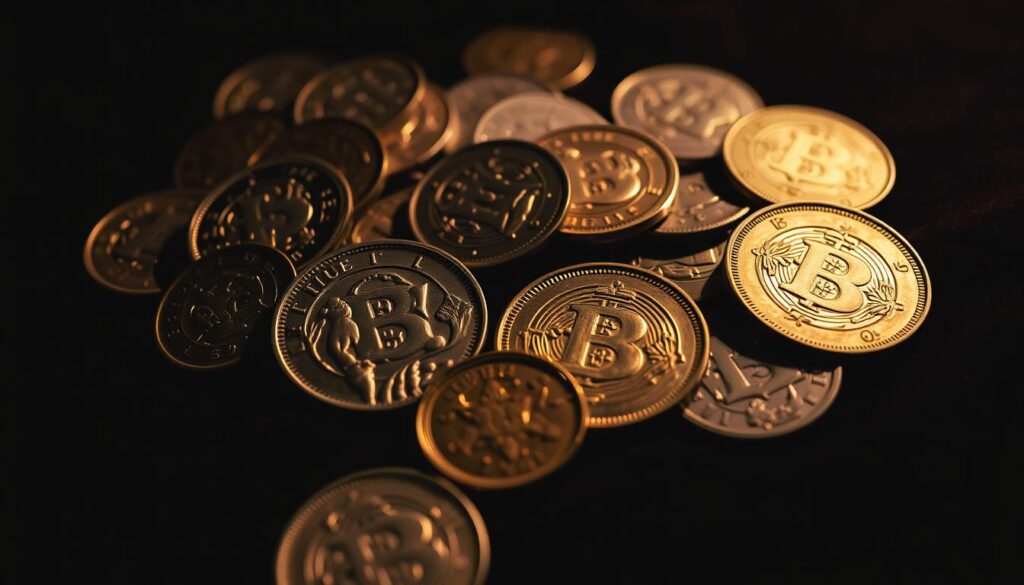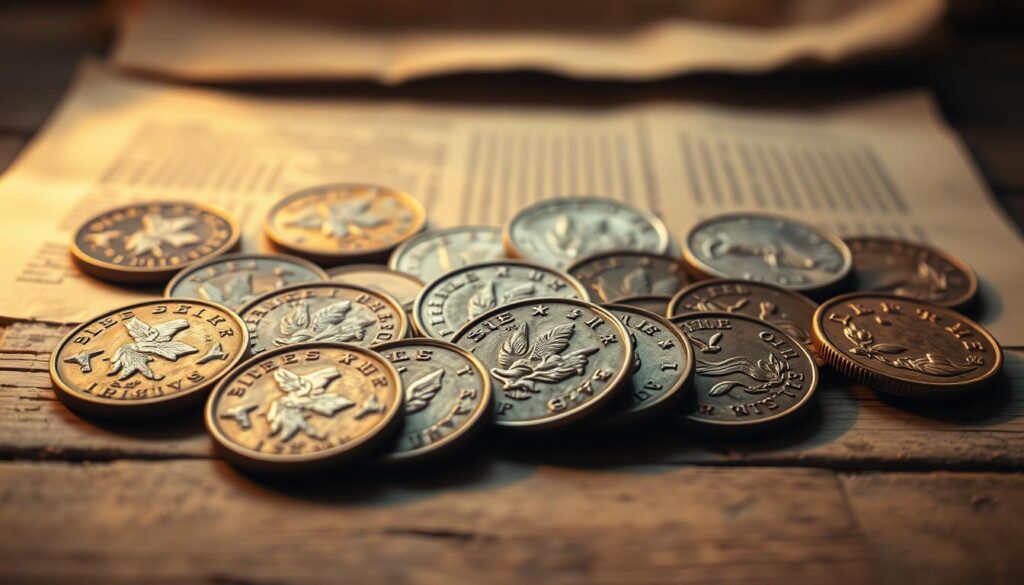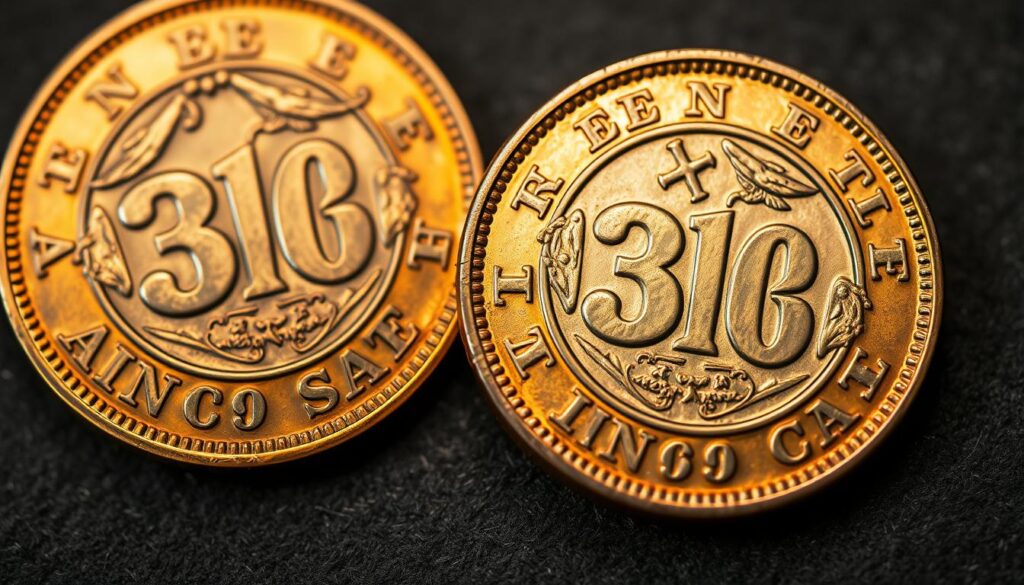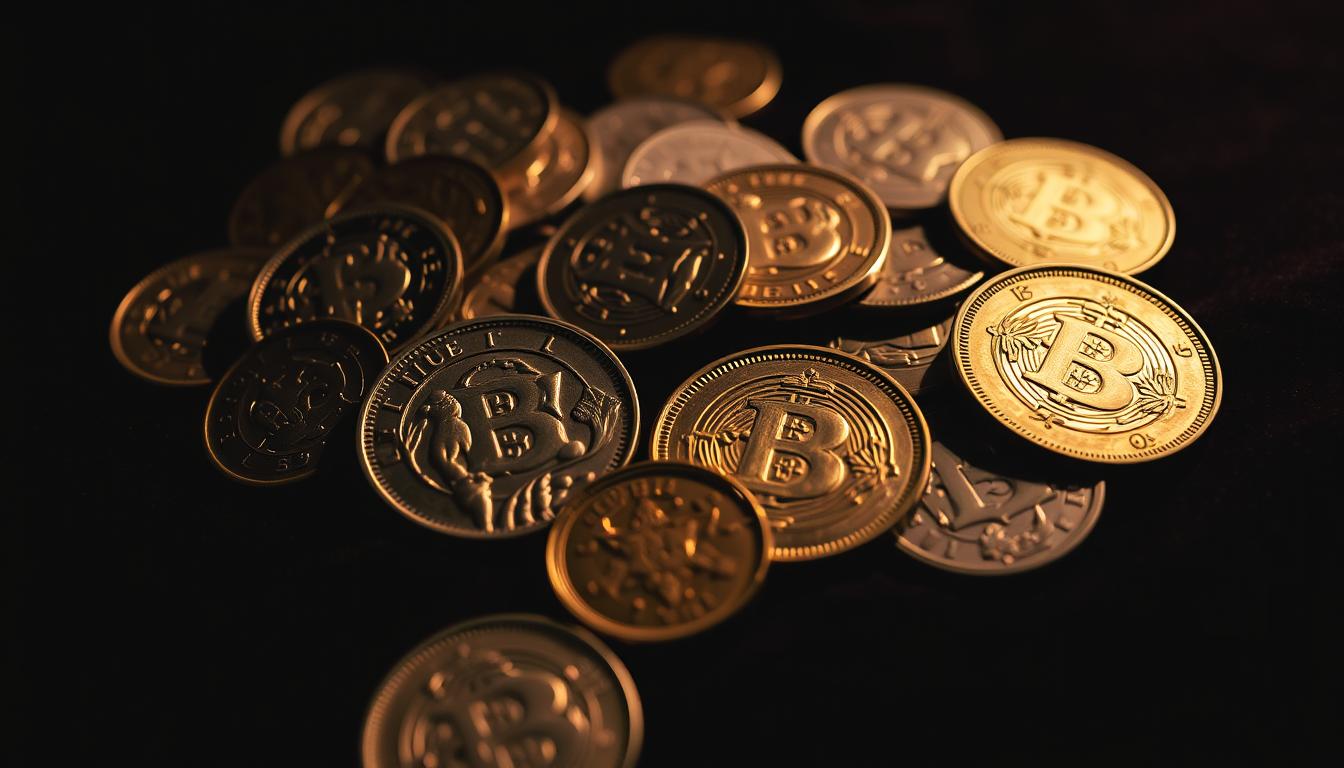Welcome to the world of numismatics, where rare coins with hidden features can increase their value. These coins are highly sought after by collectors. Rare coins are fascinating, and hidden features make them even more valuable.

As a collector, you know the thrill of finding unique and valuable coins. The world of numismatics is full of surprises. Hidden features in rare coins are one of the most exciting parts of collecting.
Introduction to Rare Coins
Rare coins with hidden features are a treasure for collectors. They offer a mix of history, rarity, and intrigue. The presence of hidden features can greatly impact a coin’s value, making it a prized possession for numismatics enthusiasts.
Key Takeaways
- Rare coins with hidden features can increase their value and make them highly sought after by collectors.
- Hidden features in rare coins can include secret markings, concealed elements, or other microscopic details.
- The study of numismatics reveals that hidden features in rare coins can be a major factor in determining their worth.
- Rare coins with hidden features are a treasure trove for collectors, offering a unique combination of history, rarity, and intrigue.
- The presence of hidden features can significantly impact the value of a coin.
- Numismatics enthusiasts can discover rare coins with hidden features through careful study and research.
Understanding the World of Rare Coins with Hidden Features
Coin collecting is more than just collecting coins. It’s about learning the history and importance of each coin. Rare coins with hidden features are especially interesting. These can include small inscriptions, symbols, or even mistakes, making each coin special and valuable.
For collectors, these hidden features are key. They show the coin’s history and the skill that went into making it. Hidden features can also make a coin more valuable, making it a prized part of any collection. Whether it’s a rare coin with a unique symbol or a coin with a mistake, these features make collecting coins exciting and rewarding.
- Unique symbols or inscriptions that set them apart from other coins
- Deliberate errors that add to their rarity and value
- Historical significance that provides a glimpse into the past
Coin collecting needs patience, dedication, and a sharp eye for detail. For those who love rare coins with hidden features, the joy is worth the hard work. With the right knowledge, collectors can discover the secrets of these hidden features and truly appreciate their coins.
The Most Valuable Secret Markings in Numismatics
Numismatics is the study of coins and currency. It’s a field that shows us the history and culture of ancient times. Secret markings on valuable coins are especially interesting. These hidden details can greatly increase a coin’s value and give us a peek into the past.
Secret markings in numismatics can be symbols, inscriptions, or images of gods and goddesses. For instance, ancient Greek coins like the Decadrachm have hidden inscriptions. These markings are not just beautiful but also carry historical and cultural importance. This makes them very desirable among collectors.
Coins from ancient Greece and Rome often have the most valuable secret markings. These can include:
- Hidden inscriptions that reveal the coin’s significance or the ruler’s name
- Symbols that represent the coin’s value or the issuing authority
- Images of gods and goddesses that reflect the cultural and religious beliefs of the time
Understanding secret markings in numismatics requires knowledge of history, culture, and coinage. By studying these markings, collectors and researchers can learn about the past. They can also appreciate the skill and creativity that went into making these valuable coins. Whether you’re a seasoned collector or new to numismatics, finding secret markings can be an exciting journey that adds depth and meaning to your collection.
Detecting Microscopic Details in Historic Coins
When it comes to historic coins, microscopic details are key. They help figure out if a coin is real and how much it’s worth. Collectors and numismatists use special methods to check these coins. They look for hidden marks or wear using feature detection.
By looking at historic coins with powerful microscopes, experts find tiny details that are hard to see. These details are crucial for understanding the coin’s history and value.
To find these tiny details, collectors need the right tools. Some important tools for feature detection are:
- High-powered microscopes
- Specialized lighting equipment
- Magnifying glasses
With these tools, collectors can look closely at historic coins. They check for hidden marks, like those on the coin’s edge or reverse side. Feature detection also helps confirm the coin’s history and if it’s been worn down.
It’s important to check if a coin is real. By using feature detection and knowing the coin’s history, collectors can be sure of their finds. Whether you’re new to collecting or have been at it for years, finding microscopic details in historic coins is both fun and educational.
Revolutionary War Era Coins and Their Concealed Messages
The Revolutionary War era was a time of great change in the United States. Coins were used to spread messages of freedom and liberty. These coins are valuable and sought after by collectors for their historical significance and hidden features.
The “Liberty Tree” coin is a famous example. It has a small inscription of “Liberty” on a tree. Other coins, like the “Liberty Bell” coin, also have hidden messages. These coins offer a glimpse into American history.
Some key features of these coins include:
- Hidden inscriptions, such as “Liberty” or “Freedom”
- Small symbols, such as the Liberty Tree or Liberty Bell
- Concealed marks, such as a small “L” or “F” on the coin’s surface

Collectors must be careful to authenticate these coins, as many are fake. By studying these coins, collectors learn about the Revolutionary War era. The study of Revolutionary War coins and their concealed messages is fascinating. It continues to interest collectors and historians, with coins being a key area of study.
Hidden Mint Marks and Their Significance
Mint marks are small letters or symbols that show where a coin was made. They are key in figuring out coin values. You can find them on the coin’s back or edge. Knowing where they are helps collectors spot rare coins.
Some mint marks are rarer than others, which can raise a coin’s value. For instance, an “S” mark means it was made in San Francisco. This can make the coin more valuable. So, collectors need to know about these marks to check a coin’s real value.
- Mint mark location and rarity
- Condition and authenticity of the coin
- Demand for the coin among collectors
Understanding these points helps collectors make smart choices when buying or sellingrare coins. It shows how important mint marks are in setting coin values.
Double Die Varieties and Secret Features
Double die varieties are special coins with errors. They happen when a die is not aligned right. This makes the coin unique and often valuable. These coins might have secret features like small inscriptions that boost their worth.
Collectors love these coins because they’re rare and full of history. Some double die varieties are rarer than others. This makes them very valuable to collectors. For instance, a coin with a doubled date or mint mark is highly sought after.

It’s important for collectors to know about different coin errors. This includes double die varieties. Understanding how coins are made and the errors that can happen helps appreciate these unique coins. Key things to look at when evaluating double die varieties include:
- The severity of the error
- The rarity of the coin
- The presence of secret features
- The historical significance of the coin
By looking at these factors, collectors can understand the value and importance of double die varieties. Whether you’re new to collecting or have been doing it for years, exploring these coins is worth it.
Modern Coins with Intentionally Hidden Elements
Modern coins often have hidden elements to stop counterfeiting. These can include microprinting, holograms, and more. Many countries use these features in their money.
Some examples of hidden elements in modern coins include:
- Security threads that glow under ultraviolet light
- Microprinting that requires a magnifying glass to read
- Holograms that reflect light and create a three-dimensional image
Some coins also have special features for collectors. These can be small inscriptions or symbols that make the coin more valuable. Techniques like laser engraving can add unique touches to coins. Collectors love coins with these special features.
The use of hidden elements in coins has led to new technologies. This includes advanced minting processes and security feature integration. These coins are now a big interest for collectors and researchers.
Preserving and Documenting Hidden Features
Keeping rare coins safe and documented is key to their value and authenticity. Collectors should use special storage like protective albums or folders. These keep coins safe from damage and wear.
Also, taking high-quality photos and writing detailed descriptions is important. It helps track a coin’s unique features and proves its origin.
Secure Storage Strategies
Choosing the right storage is crucial for coins with hidden features. Albums and folders made from acid-free materials protect coins. They keep them safe from light, humidity, and handling.
Comprehensive Documentation Practices
Documenting coins’ hidden features is essential. High-quality photos and detailed records create a digital archive. This archive showcases a coin’s unique traits and proves its authenticity.
It’s not just rare coins with hidden features—the strangest gadgets from the 1900s will surprise you too
FAQ
What constitutes a hidden feature in a coin?
A hidden feature can be many things. It might be a small inscription, a symbol, or even a mistake. These features can be found worldwide and greatly increase a coin’s value.
Why do hidden features matter to collectors?
Hidden features offer a unique look into a coin’s history and creators. They also make coins rarer and more valuable. This makes them highly sought after by collectors.
What are some of the most valuable secret markings in numismatics?
Coins from ancient places like Greece and Rome have valuable secret markings. These can include symbols, inscriptions, and images of gods and goddesses.
What tools are essential for detecting microscopic details in historic coins?
A high-powered microscope is key for spotting tiny details. Collectors should also know where to look for hidden marks, like the coin’s edge or reverse side.
What is the significance of hidden mint marks on coins?
Mint marks show where a coin was made. Some coins have hidden mint marks in spots like the reverse side or edge. Knowing where to find these can help value and verify a coin.
What are double die varieties and how do they relate to secret features?
Double die varieties have misaligned or doubled images, often from minting errors. Some have secret features like inscriptions or symbols, boosting their value.
What types of hidden elements can be found in modern coins?
Modern coins often have hidden security features to prevent counterfeiting. Some also have collector edition features like inscriptions or symbols, adding value.
How can collectors preserve and document hidden features on their coins?
Keeping hidden features safe and documented is vital. Use coin albums or folders for protection. Take high-quality photos and write detailed descriptions to track and prove your coins’ authenticity.
